Rameshwaram is a town steeped in spirituality, history and natural beauty, situated on Pamban Island, separated from mainland India by the Pamban Channel. Known as the “Varanasi of the South,” it is one of the most sacred places for Hindus and a significant pilgrimage destination. This coastal town offers a unique blend of religious fervor, ancient architecture, and scenic landscapes, making it a must-visit for every traveler.
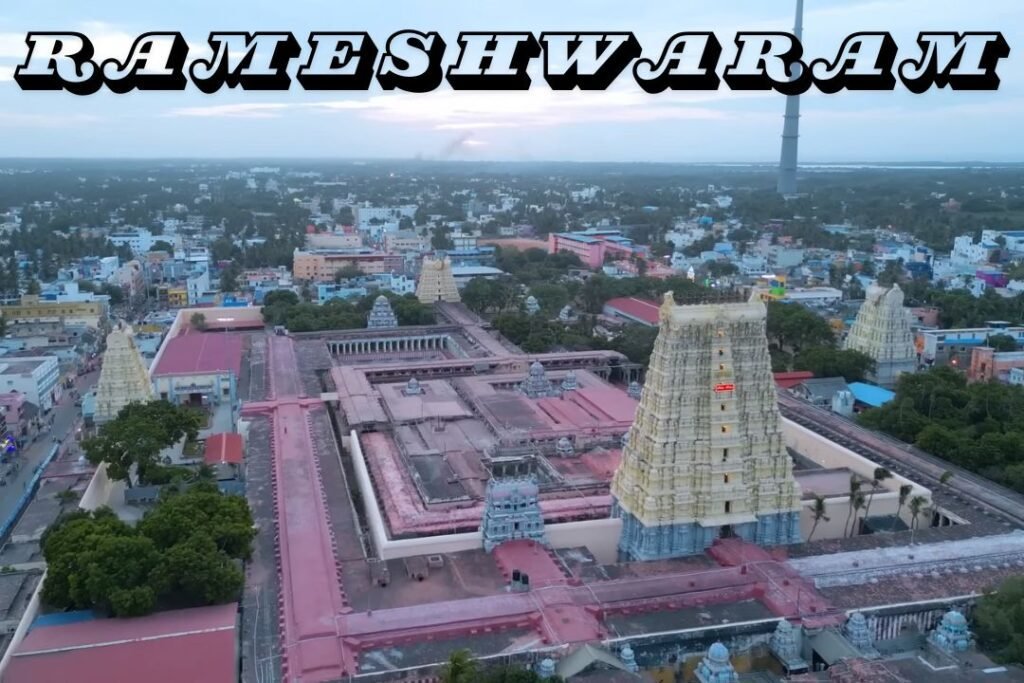
Table of Contents
Key Points
Spiritual Significance
Rameshwaram is renowned for its religious importance in Hinduism. It is believed to be the place where Lord Rama built a bridge across the sea to rescue his wife Sita from the demon king Ravana, as described in the epic Ramayana. The Ramanathaswamy temple (Rameshwaram Temple), dedicated to Lord Shiva, is one of the main pilgrimage sites among the twelve Jyotirlinga temples and four dhamas. The temple’s grand corridors, massive sculpted pillars, and sacred water tanks (teerthams) are architectural marvels that attract devotees and tourists alike. The town is home to numerous temples, each with its own unique story and significance.
Historical Significance
The Ramanathaswamy Temple (Rameshwaram Temple), one of the most revered temples in India, holds immense historical and mythological significance. According to Hindu mythology, Lord Rama, an avatar of Vishnu, prayed to Lord Shiva here to absolve himself of the sin of killing Ravana, a Brahmin king. He instructed Hanumanji to bring a lingam from the Himalayas. However, as Hanumanji’s return was delayed, Sitamata made a small lingam out of sand, which Lord Rama worshipped. This lingam, known as the Ramalingam, is the main deity of the temple.
Architecture
The Ramanathaswamy Temple (Rameshwaram Temple) is a stunning example of Dravidian architecture, known for its grandeur and intricate details.
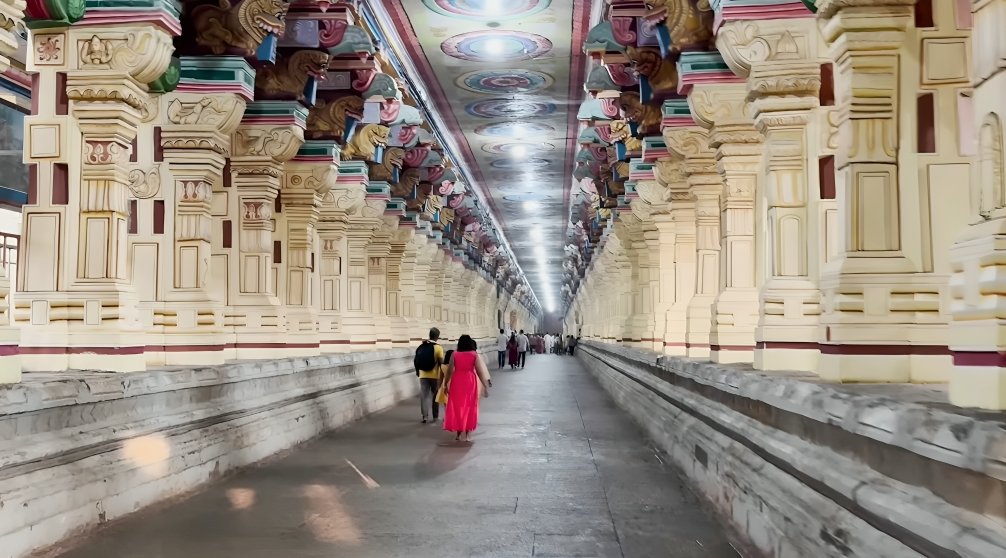
Nandi Statue: A colossal statue of Nandi, Shiva’s sacred bull, sits within the temple premises. This statue is one of the largest Nandi statues in India.
Mandapams: The temple complex includes several mandapams (halls) used for various rituals and ceremonies. These halls are intricately designed and add to the temple’s architectural splendor.
Corridors: The temple is renowned for having the longest corridor among all Hindu temples in India. These corridors are adorned with massive sculpted pillars and intricate carvings. The outer corridor is about 6.9 meters high and stretches over 1,200 meters in total length, comprising nearly 4,000 pillars.
Gopurams (Gateways): The temple has imposing gopurams (gateway towers) at its entrances. The eastern gopuram stands at around 53 meters and is adorned with elaborate sculptures depicting various deities and mythological scenes.
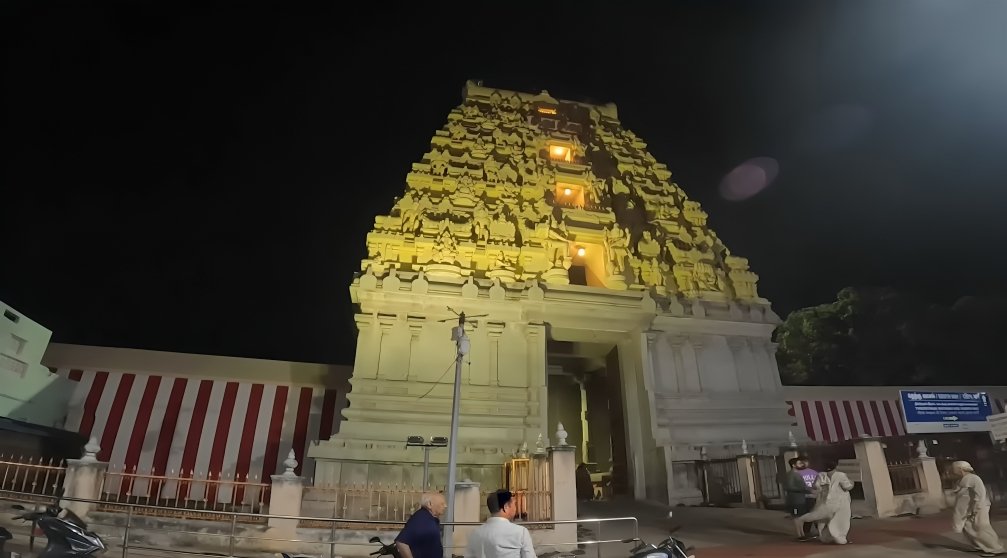
Rituals and Teerthams
Rituals at Ramanathaswamy Temple (Rameshwaram Temple) follow ancient traditions and are believed to purify the soul and absolve sins.
Teerthams: The temple complex houses 22 holy water tanks, known as teerthams, each with its own significance. Pilgrims typically begin their visit with a bath in the sea at Agnitheertham, followed by bathing in the temple’s 22 teerthams. People perform this ritual believing that this ritual purifies the body and soul.
Abhishekam: Devotees perform abhishekam (ritualistic bathing) of the Shiva lingam with sacred substances like milk, honey, ghee, and sandalwood paste. This is accompanied by chanting of Vedic hymns and prayers.
Special Pujas: Special pujas and rituals are conducted during major festivals like Maha Shivaratri and Navaratri. These rituals are elaborate and involve processions, music, dance, and devotional singing.
Linga Worship: The main deity, the Ramalingam, is worshipped along with the Vishwalingam. The Vishwalingam was brought by Hanuman and is worshipped before the Ramalingam as per Lord Rama’s instructions.
Festivals
Ramanathaswamy Temple (Rameshwaram Temple) is a hub of activity during various Hindu festivals, drawing thousands of devotees.
Maha Shivaratri: This festival is dedicated to Lord Shiva and involves night-long vigils, fasting, and special prayers. The temple witnesses grand celebrations with music, dance, and religious processions.
Navaratri: Celebrated over nine nights, Navaratri honors the goddess Durga in her various forms. The temple is beautifully decorated and various cultural events are also organized.
Rama Navami: This festival celebrates the birth of Lord Rama and includes recitations of the Ramayana, special pujas, and cultural performances.




Architecture and Artistry
The Ramanathaswamy Temple (Rameshwaram Temple) is not only a place of worship but also an architectural masterpiece. The temple’s construction showcases the skill and artistry of the Dravidian architectural style, which flourished under the patronage of various South Indian dynasties. The temple’s architecture includes the following features:
Granite Columns and Sculptures: The granite columns of the temple’s corridors are adorned with intricate sculptures depicting scenes from Hindu mythology, deities, and various mythological figures. These carvings are a testament to the artisans’ skill and creativity.
Vimana (Temple Tower): The vimana, or the tower above the sanctum sanctorum, is intricately carved and richly decorated. It stands as a symbol of the temple’s spiritual significance and architectural grandeur.
The Thousand Pillar Hall: The temple complex includes a hall with a thousand pillars, each one uniquely carved with exquisite detail. This hall is a marvel of symmetry and artistry, reflecting the temple’s architectural brilliance.
Surrounding Attractions of Rameshwaram
Laxman Theertham
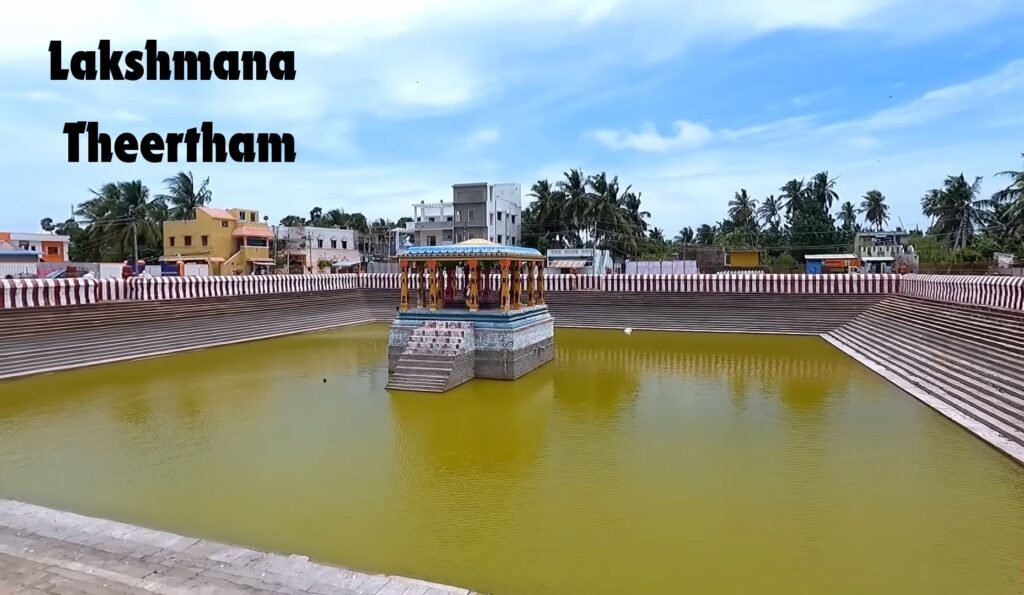
Religious Significance: Laxman Theertham is named after Lord Rama’s brother, Laxman. It is believed that Laxman performed penance here to seek forgiveness for his sins during the battle against Ravana.
Holy Water: The theertham (holy tank) is considered sacred, and pilgrims take a dip in its waters believing it will purify them and absolve their sins.
Temple Structure: The temple dedicated to Laxman is simple yet spiritually significant. It attracts devotees who come to offer prayers and perform rituals.
Location: It is located close to the Ramanathaswamy Temple, making it easily accessible for pilgrims visiting Rameshwaram.
Festivals: During festivals like Ram Navami and Diwali, Laxman Theertham sees a significant influx of devotees who participate in special prayers and rituals.
Ram Theertham
Mythological Importance: Ram Theertham is associated with Lord Rama, where it is believed he took a bath to purify himself after defeating Ravana.
Sacred Tank: The theertham is considered holy, and taking a dip in its waters is believed to cleanse one’s soul and body.
Temple: There is a temple dedicated to Lord Rama near the theertham, where devotees offer their prayers and seek blessings.

Tranquil Atmosphere: The surroundings of Ram Theertham are peaceful, providing a serene environment for meditation and reflection.
Accessibility: It is situated conveniently close to other major attractions in Rameshwaram, making it a frequent stop for pilgrims and tourists.
Panchmukhi Hanuman Temple
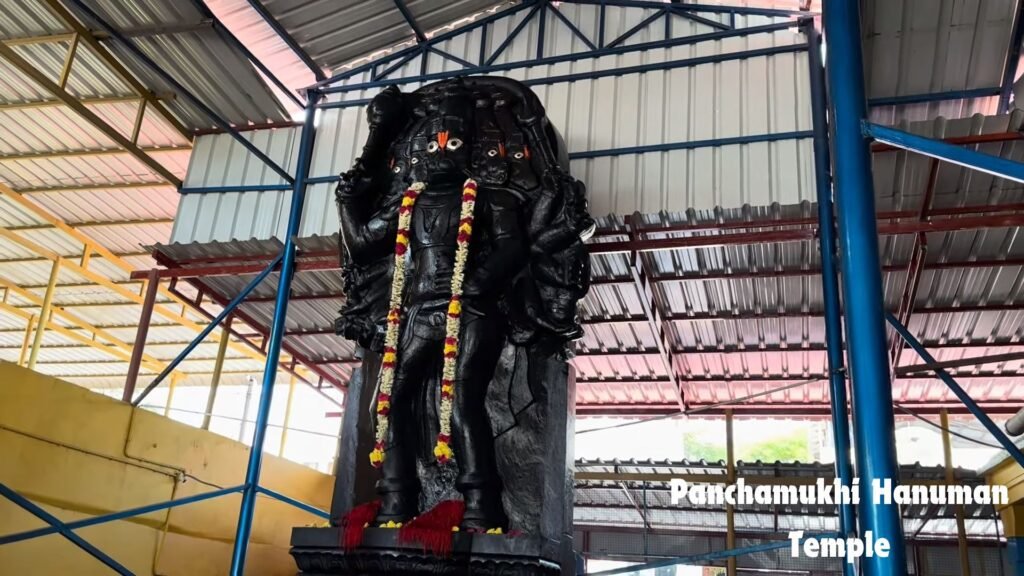
Five-Faced Idol: The temple is famous for its unique idol of Hanuman with five faces, representing the five forms of the deity – Hanuman, Narasimha, Garuda, Varaha, and Hayagriva.
Spiritual Significance: Devotees believe that worshipping Panchmukhi Hanuman can remove obstacles, provide protection, and bestow strength.
Floating Stone: The temple houses a floating stone, believed to have been used in the construction of the Rama Setu, attracting significant attention and reverence.
Festivals and Rituals: Special prayers and rituals are conducted on Hanuman Jayanti and other significant Hindu festivals, drawing large crowds of devotees.
Villoondi Theertham
Mythological Story: According to legend, Villoondi Theertham is the place where Lord Rama shot an arrow into the ground to create a freshwater spring to quench Sitamata’s thirst.
Freshwater Spring: The unique feature of Villoondi Theertham is the freshwater spring found amidst the saltwater sea, considered a miracle by devotees.
Scenic Beauty: The location offers stunning views of the sea and is a peaceful spot for visitors to relax and reflect.
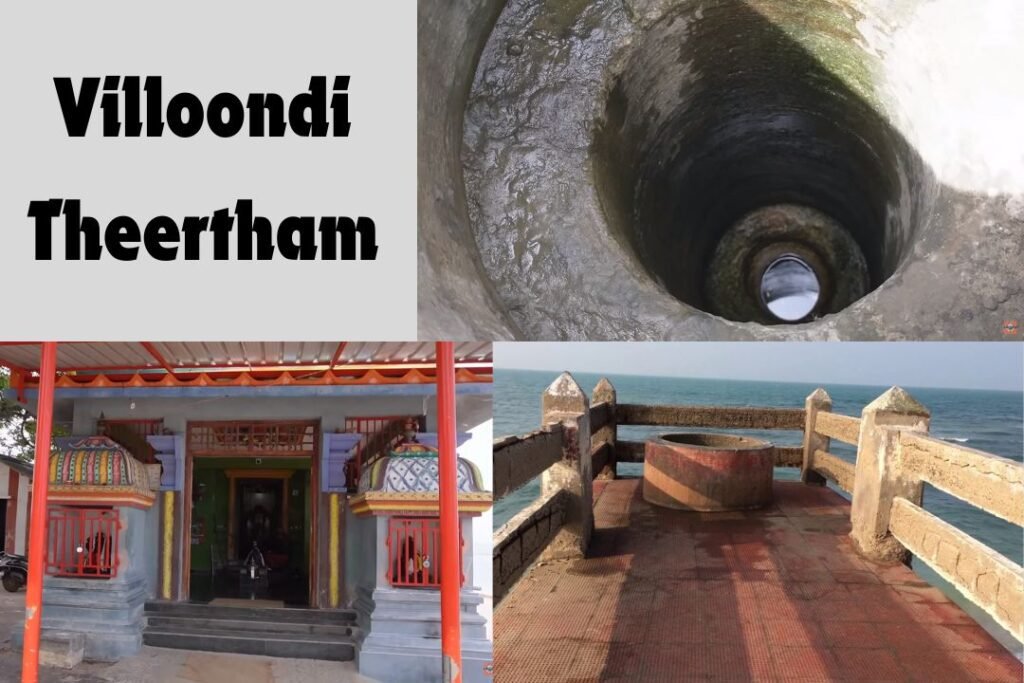
Religious Importance: Pilgrims visit Villoondi Theertham to take a dip in the sacred waters, believed to have healing properties.
Accessibility: It is located a short drive from Rameshwaram, making it an easily accessible attraction for tourists and pilgrims.
Dr. A.P.J. Abdul Kalam House & Memorial

Birthplace of a Legend: This house is the birthplace of Dr. APJ Abdul Kalam, India’s former President and renowned scientist, located in Rameshwaram.
Museum: The house has been converted into a museum displaying various photographs, memorabilia, and personal belongings of Dr. Kalam, offering insights into his life and achievements.
Inspiration: The museum serves as a source of inspiration, especially for young visitors, highlighting Dr. Kalam’s humble beginnings and illustrious career.
Library: There is a small library within the museum featuring books written by and about Dr. Kalam, encouraging visitors to read and learn.
Tourist Attraction: It is a popular tourist spot, attracting visitors who wish to pay homage to one of India’s most respected and beloved figures.
Pamban Bridge
Engineering Marvel: The Pamban Bridge, India’s first sea bridge, connects Pamban Island to the mainland and is an engineering marvel. It spans nearly 2.3 km over the sea.
Cantilever Bridge: The bridge is a cantilever type, with a section that can be raised to allow ships and ferries to pass through.
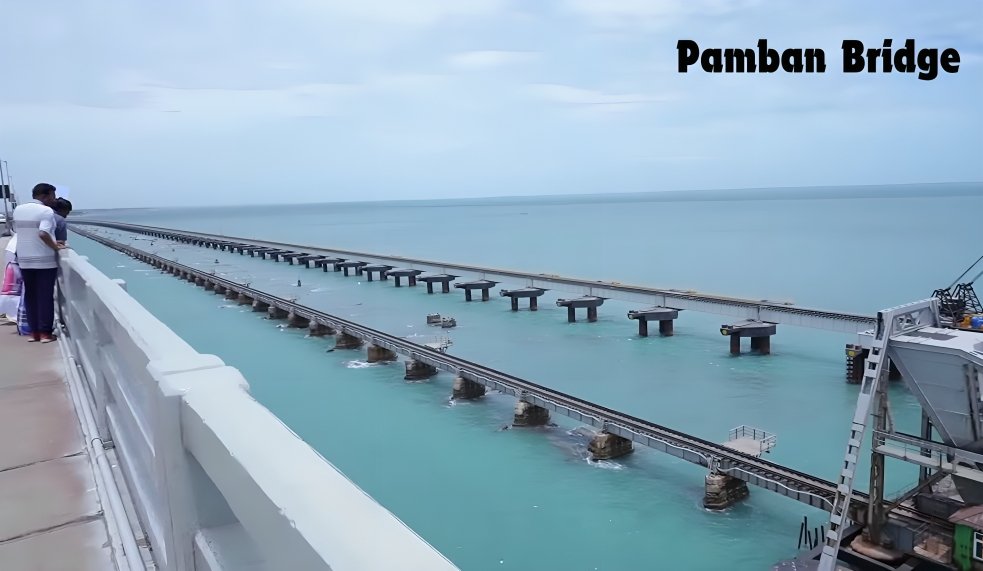
Scenic Views: Traveling across the bridge offers breathtaking views of the surrounding ocean and landscape, making it a favorite spot for photographers.
Historical Significance: Opened in 1914, it has historical significance and remains a vital link for transportation and connectivity.
Rail and Road: Adjacent to the road bridge is the Pamban Railway Bridge, which provides a unique experience as trains cross over the sea.
Dhanushkodi

Ghost Town: Dhanushkodi, once a thriving town, was destroyed by a cyclone in 1964 and now stands as a ghost town with ruins of churches, railway stations, and homes.
Mythological Importance: It is believed to be the site where Lord Rama ordered the destruction of the Rama Setu bridge with one end of his bow (Dhanush).
Scenic Beauty: The meeting point of the Bay of Bengal and the Indian Ocean offers stunning views and a serene atmosphere.
Adventure: Accessible only by four-wheel-drive vehicles, the journey to Dhanushkodi is an adventure in itself, crossing sandy paths and scenic landscapes.
Bird Watching: The area is a haven for bird watchers, with many migratory birds visiting the region, adding to its natural charm.
Ram Setu (Adam’s Bridge)
Mythological Significance: Ram Setu, also known as Adam’s Bridge, is believed to be the bridge built by Lord Rama’s army to cross over to Lanka as mentioned in the Ramayana.
Geological Interest: The bridge is a chain of limestone shoals, stretching about 50 km from Pamban Island to Sri Lanka, and is of significant geological interest.

Aerial Views: Aerial views of the bridge, visible from above, provide a spectacular sight and are a major attraction for tourists.
Scientific Studies: The formation and age of the bridge have been subjects of various scientific studies and debates, adding to its intrigue.
Pilgrimage Site: It is considered a sacred site, with many pilgrims visiting to offer prayers and pay homage to the mythological significance of the bridge.
Rameshwaram Lighthouse

Guiding Light: The Rameshwaram Lighthouse stands as a beacon for ships and boats navigating the coastal waters of Rameshwaram.
Scenic Views: Visitors can climb to the top of the lighthouse to enjoy panoramic views of the town, the sea, and the surrounding islands.
Historical Significance: Built in the early 20th century, the lighthouse has historical significance and has played a crucial role in maritime navigation.
Architectural Design: The structure is an example of colonial-era architecture, with its sturdy build and classic design.
Tourist Attraction: The lighthouse is a popular tourist attraction, offering insights into the region’s maritime history and providing a unique vantage point.
How to Reach
By Air
Nearest Airport: Madurai Airport (IXM) is the nearest airport to Rameshwaram, which is about 170 km away.
Domestic Flights: Madurai Airport is well-connected with major Indian cities like Chennai, Bangalore, Mumbai, and Delhi through regular domestic flights.
International Connections: For international travelers, connecting flights via Chennai International Airport (MAA) or Bangalore International Airport (BLR) can be taken to reach Madurai.
Transportation from Madurai: From Madurai Airport, you can hire a taxi or take a bus to Rameshwaram. It takes about 3-4 hours to travel by road.
By Train
Rameshwaram Railway Station: Rameshwaram has its own railway station (RMM), which is well-connected to major cities like Chennai, Madurai, Coimbatore, and Bangalore.
Direct Trains: Regular direct trains, such as the Rameshwaram Express from Chennai, Sethu Express from Chennai, and trains from Bangalore and Madurai, operate to and from Rameshwaram.
Scenic Route: The train journey to Rameshwaram offers scenic views, especially when crossing the iconic Pamban Bridge, providing a unique travel experience.
By Road
Well-Connected Roads: Rameshwaram is well-connected by road to major cities in Tamil Nadu and neighboring states via a network of highways.
Self-drive: For those preferring to drive, the route from Madurai to Rameshwaram via NH87 is a popular choice, taking approximately 3-4 hours.
Buses: Tamil Nadu State Transport Corporation (TNSTC) and private operators run regular bus services from cities like Chennai, Madurai, Trichy, and Coimbatore to Rameshwaram.
Private Taxis: Hiring a private taxi is a convenient option for a more comfortable journey, especially if traveling with family or in a group.
Tourist Buses: Several tour operators offer package tours to Rameshwaram, which include transportation and guided tours of the key attractions.
By Sea (Limited and Seasonal)
Ferry Services: There are occasional ferry services from coastal cities like Chennai to Rameshwaram, though these are less common and more seasonal.
Scenic Journey: Traveling by sea offers a unique experience and scenic views, but it’s important to check the availability and schedule in advance.
Private Charters: For an exclusive and adventurous option, private charters and boats can be hired from nearby coastal areas, though this is a more expensive option.
Local Transportation
Auto-Rickshaws: Auto-rickshaws are a common and convenient mode of transport within Rameshwaram.
Taxis: Taxis can be hired for local sightseeing or for longer trips. It’s advisable to negotiate the fare in advance or use app-based services if available.
Bicycles and Scooters: Renting bicycles or scooters is a popular option for tourists who want to explore Rameshwaram at their own pace.
Tourist Vans: For group travelers, hiring a tourist van can be a convenient option for visiting multiple sites in and around Rameshwaram.
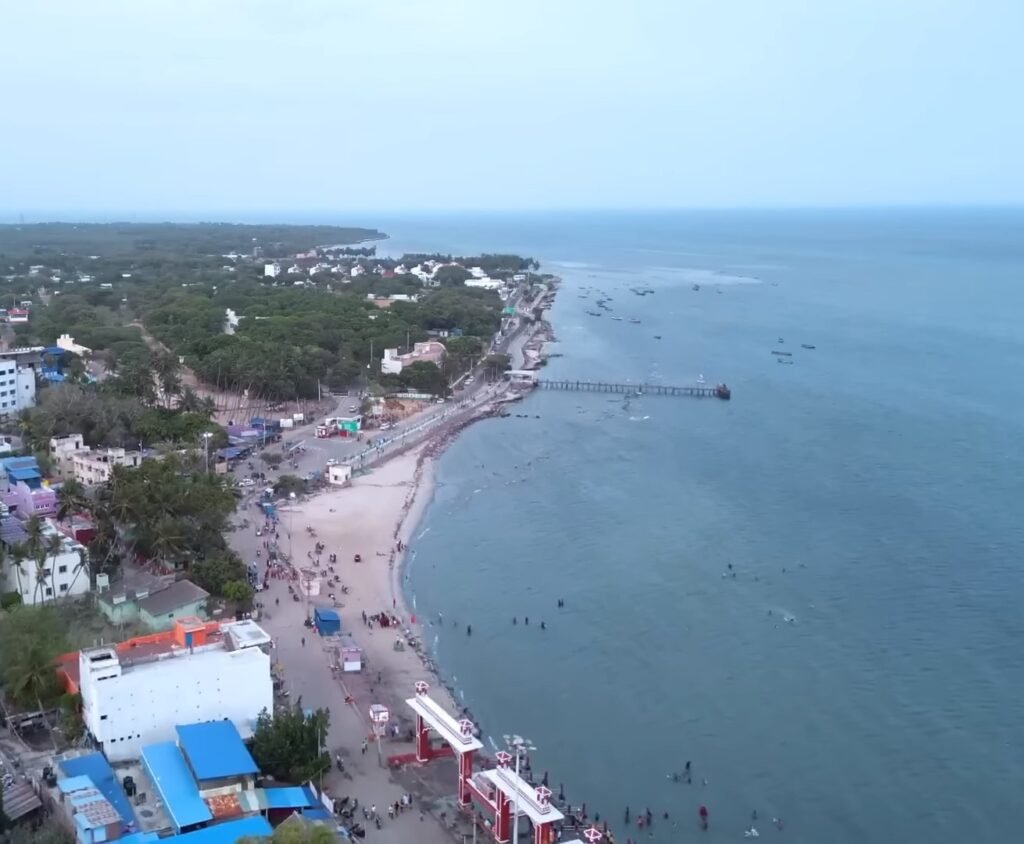
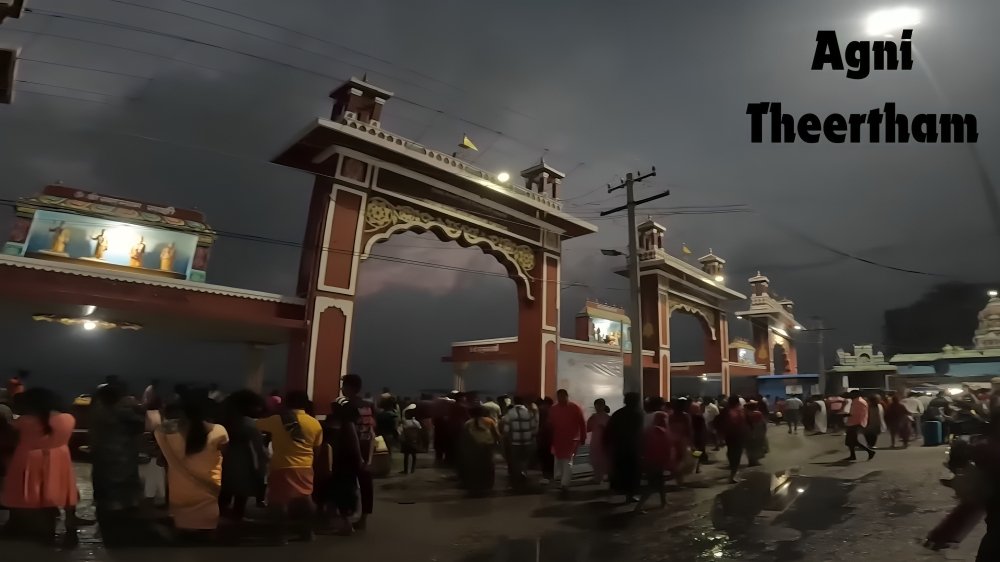
Accommodations
Luxury Hotels
- Hyatt Place Rameshwaram: Conveniently located close to the Ramanathaswamy Temple and other attractions.
- Daiwik Hotels Rameshwaram: Near the Ramanathaswamy Temple, making it a great choice for pilgrims.
- Saaral Residency: Centrally located, offering easy access to major tourist spots.
Mid-Range Hotels
- Hotel Ashoka: Situated close to the Ramanathaswamy Temple and the main market.
- Hotel Pearl Residency: Located near the railway station and the temple.
- Jiwan Residency: Proximity to the beach and the Ramanathaswamy Temple.
Budget Hotels
- Hotel Temple Tower: Close to the Ramanathaswamy Temple and other local attractions.
- Blue Coral Cottage: Near the temple and the beach.
- Hotel MCM Towers: Conveniently located near the temple and market area.
Guesthouses and Lodges
- Nandavanam Guest House: A short distance from the Ramanathaswamy Temple.
- Siva Lodge: Located near the temple and other tourist spots.
- Sri Sarvesha JS Palace: Close to the temple and beach.
Local Cuisine of Rameshwaram
Dosa: Thin, crispy pancakes made from fermented rice and lentil batter, served with a variety of chutneys and sambar.
Idli and Vada:
- Idli: Steamed rice cakes, soft and fluffy, typically served with coconut chutney and sambar.
- Vada: Deep-fried savory doughnuts made from lentils, crispy on the outside and soft on the inside.
Sambar: A lentil-based vegetable stew cooked with tamarind broth and a unique blend of spices.
Pongal: A popular breakfast dish made from rice and moong dal, seasoned with black pepper, cumin, and ghee. Served with chutney and sambar.
Kootu: A semi-solid curry made with vegetables and lentils, flavored with coconut and spices. Often eaten as a side dish with rice.
Rasam: A hot and spicy soup made with tamarind juice, tomatoes and a mixture of spices. Often served with rice.
Chettinad Cuisine: Known for its spiciness and aromatic flavors, Chettinad cuisine includes dishes like Chettinad chicken, pepper chicken, and fish curry.
Seafood Delicacies: Being a coastal town, Rameshwaram offers a variety of fresh seafood dishes like fish curry, prawn masala, crab curry, and fish fry.
Appam and Stew
Appam: A Soft, lacy pancakes made from fermented rice batter.
Stew: A mild curry made with coconut milk, vegetables or meat, flavored with spices.
Sweet Treats:
- Payasam: A sweet pudding made from rice or vermicelli, cooked with milk, sugar, and flavored with cardamom and nuts.
- Kesari: A semolina-based sweet dish cooked with ghee, sugar, and flavored with saffron and cardamom.
Travel Tips and Safety Advice
Plan Your Itinerary: Research and plan your itinerary in advance. Rameshwaram has many attractions including the Ramanathaswamy Temple, Dhanushkodi, and various theerthams.
Best Time to Visit: The best time to visit Rameshwaram is during the months of October to April when the weather is pleasant. Avoid the monsoon season (July to September) due to heavy rains and possible cyclones.
Dress Appropriately: When visiting temples and religious sites, dress modestly. Men are usually required to remove their shirts and wear a veshti (traditional cloth) at the Ramanathaswamy Temple.
Footwear: You will need to remove your footwear before entering temples. It’s advisable to wear easily removable shoes or sandals.
Hydration and Sun Protection: Carry a water bottle to stay hydrated and use sunscreen, hats, and sunglasses to protect yourself from the sun, especially if you plan to spend time on the beach or in open areas.
Local Currency: Ensure you have sufficient local currency (Indian Rupees) for small purchases, as not all places accept credit or debit cards. ATMs are available but may not be conveniently located near all attractions.
Respect Local Customs: Be respectful of local customs and traditions, especially in religious places. Follow the rules and guidelines provided by temple authorities.
Photography: Capture the stunning views at Pamban Bridge, Dhanushkodi Beach, and the Ramanathaswamy Temple corridors for memorable photographs.
Stay Vigilant: While Rameshwaram is generally safe, it’s important to stay vigilant, especially in crowded places.
Health Precautions: Carry basic medications and a first aid kit. Drink bottled or purified water to avoid water-borne diseases. If you have any specific medical conditions, carry a sufficient supply of your medications.
Safe Swimming: If you plan to swim at the beach, ensure that it is a safe and designated swimming area. Be cautious of strong currents and tides. Avoid swimming alone.
Weather Alerts: Check weather forecasts and stay informed about any potential cyclones or adverse weather conditions, especially during the monsoon season.
Respect Wildlife: If visiting areas like Dhanushkodi, respect the local wildlife and avoid disturbing their natural habitat.
Conclusion
Rameshwaram is a unique destination that offers a perfect blend of spirituality, history, adventure, and natural beauty. Whether you are a pilgrim seeking spiritual solace, a history enthusiast exploring ancient legends, or an adventure seeker looking for unique experiences, Rameshwaram has something special for everyone.
Plan your visit to this enchanting city with GujjuTraveling and immerse yourself in its rich cultural heritage and breathtaking beauty. stay connected with GujjuTraveling for information about such places.

Frequently Asked Questions (FAQs)
What is the best time to visit Rameshwaram?
The best time to visit Rameshwaram is from October to April when the weather is pleasant and ideal for sightseeing and temple visits.
How do I reach Rameshwaram?
Rameshwaram can be reached by air (nearest airport is Madurai), train (Rameshwaram Railway Station), and road (well-connected highways from major cities in Tamil Nadu).
What are the main attractions in Rameshwaram?
The main attractions include Ramanathaswamy Temple, Dhanushkodi, Pamban Bridge, APJ Abdul Kalam House & Museum, and various theerthams like Laxman Theertham and Ram Theertham.
What is the significance of Ramanathaswamy temple?
Ramanathaswamy Temple is one of the twelve Jyotirlinga temples and four dhamas dedicated to Lord Shiva and is a major pilgrimage site for Hindus.
Are there any beach activities in Rameshwaram?
Yes, Rameshwaram offers beautiful beaches like Dhanushkodi Beach and Ariyaman Beach where you can enjoy activities like swimming, sunbathing, and beachcombing.
What should I wear while visiting temples in Rameshwaram?
Dress modestly and traditionally. Men are usually required to remove their shirts and wear a veshti (traditional cloth) at the Ramanathaswamy Temple.
Is photography allowed in the temples?
Photography is generally not allowed inside the temples, but you can take pictures of the temple exteriors and other attractions around Rameshwaram.
Are there good accommodation options in Rameshwaram?
Yes, Rameshwaram offers a range of accommodation options from luxury hotels to budget guesthouses to suit different budgets and preferences.
What local cuisine should I try in Rameshwaram?
Try local dishes like dosa varieties, idli, vada, pongal, kootu, rasam, sambar, Chettinad cuisine, seafood delicacies, appam and stew, and sweet treats like payasam and kesari.
Is it safe to travel to Rameshwaram?
Rameshwaram is generally safe for tourists, but it’s important to stay vigilant, especially in crowded areas, and follow standard travel safety practices.
Can I visit Rameshwaram during the monsoon season?
It is advisable to avoid visiting Rameshwaram during the monsoon season (July to September) due to heavy rains and potential cyclones.
Is there any entry fee for the temples?
Most temples in Rameshwaram do not have an entry fee, but some might have charges for special darshan or puja services.
What are the must-visit theerthams in Rameshwaram?
Must-visit theerthams include Laxman Theertham, Ram Theertham, and Viloondi Theertham, each with its own unique religious significance.
Can I visit Dhanushkodi by public transport?
Yes, you can visit Dhanushkodi by local buses or hire a private vehicle. Special jeep services are also available to take you to the beach and ruins of the old town.

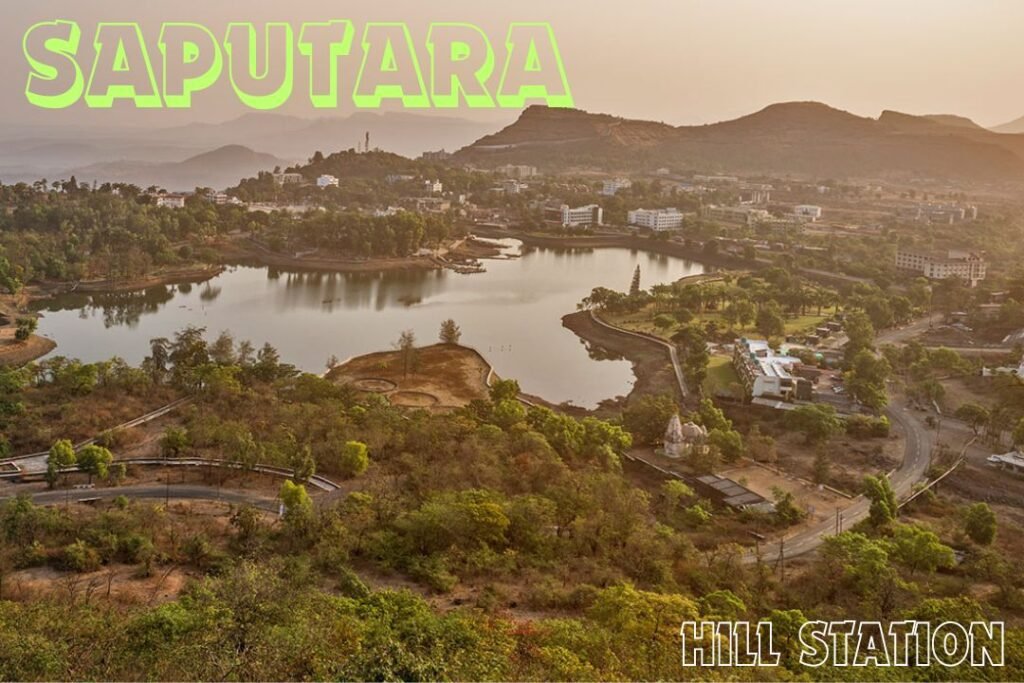
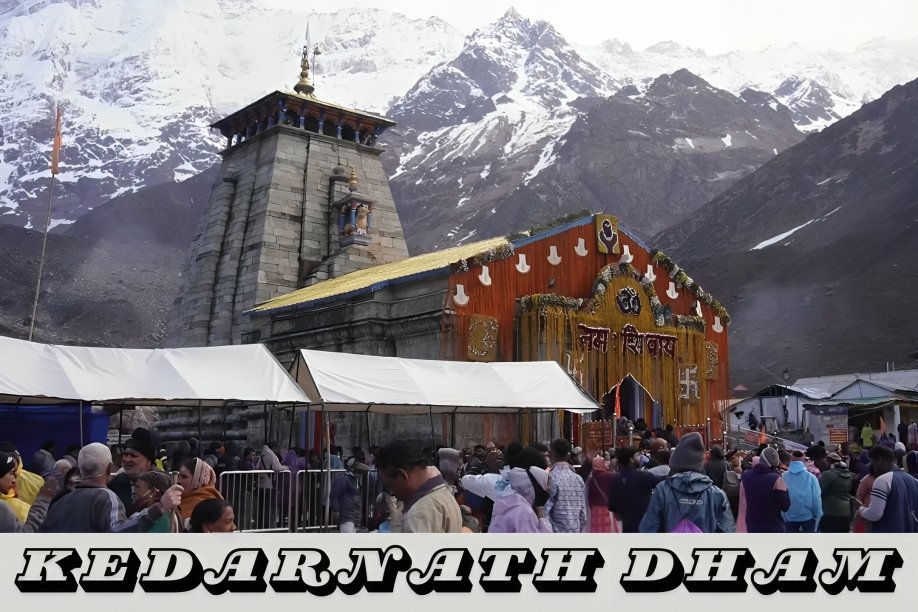
This blog is Very Usefull